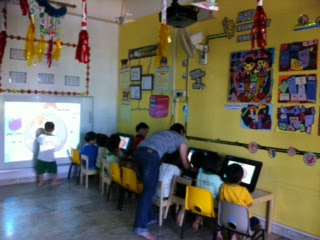According to Bruner (Smith, 2002), children are active learners and problem-solvers who are ready to be engaged in challenging task. He also further explained the principal of learning for young children from hands on before pictorial, pictorial beofre abstract. The use of technology does bridge the gap between hands on and pictorial as most Mathematics programs are presented in a form of game which allows children to be actively engaged in play. However, children still needs concrete materials first and technology cannot be used to replace hands-on learning. Thus, teachers need to assess children's learning ability before using technology to reinforce what the children are learning.
In my school, we bought the license from this company who provide us with programs in both languages. In this program, it comprises of mathematics, language, music and other components. Activities are planned to engaged children with interesting games and activities for children to play. It also provides different concept at different level and the teachers can choose the appropriate level for each child to play.
This program comes with interactive whiteboard (the touch pen), book scanner and overhead bridge projector. Teachers can do a class learning through the use of interactive whiteboard before children work as a small group or individually.
Why did we choose to incorporate technology in our school and the advantages of it:
- Opportunities to aid different learning styles.
- Different form of assessment for young children.
- The computer also offers unique opportunities for learning through exploration, creative problem solving, and self-guided instruction. (Clements,1999)
- Technical Competence Skills
- More collaboration among peers as they engage in group learning.
- Interactive learning.
- Encourage independent learning.
- Visual stimulation
The disadvantages of using technology:
- Teachers need to be savvy in the use of technology.
- Equipment failure may disrupt the lesson. Teachers need to have back up plan.
- Lesser attention span during other class time without the use of technology.
- Expose to unrelated websites. Filter needed to prevent this from happening.
Lastly, technology should be used sparingly should not be replaced by technology. Teacher and children interaction is still critical in the early years of young children. Teachers will still need to facilitate, assess and observe children's learning when using technology.
Embrace the technology of the 21st century with open arms as we prepare our children for the future.
References:
Clements, D. (n.d.). Dialogue on early childhood science, mathematics, and technology education first experiences in science, mathematics, and technology. Retrieved from http://www.project2061.org/publications/earlychild/online/experience/clements.htm?
Clements, D. (n.d.). Dialogue on early childhood science, mathematics, and technology education first experiences in science, mathematics, and technology. Retrieved from http://www.project2061.org/publications/earlychild/online/experience/clements.htm?

No comments:
Post a Comment